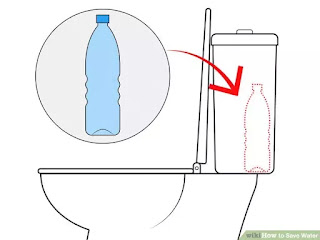1. Install low-flow shower heads and faucets or faucet aerators. Low-flow devices are inexpensive. Most simply screw into place (you may need an adjustable wrench), and good, current units maintain the pressure and feel of the flow while using as little as half as much water as conventional units.

2. Take shorter showers. Take a timer, clock, or stopwatch into the bathroom with you and challenge yourself to cut down your showering time. You could even play music while in the shower and challenge yourself to cut down the number of songs it takes you. Shave outside the shower, or turn off the shower while you shave.
Take showers rather than baths. By taking a bath, you are using up to 100 liters of water! Showering will generally use less than a third of this amount. See the water use table below.
Install a valve that fits just behind the shower head. These valves are inexpensive and simply screw into place. Turn the water on for long enough to get wet. Then, use the valve to turn the water off while preserving the temperature of the water while you soap up. Turn the water on again to rinse.

3. Use wastewater or gray water from the bath, washing machines or dish washing on the garden. If possible, hook up a hose to the outlet on your machine to send the water outside onto your garden. To re-use bathwater use a hand-operated Syphon Pump. When hand-washing dishes, rinse the dishes into a container, and empty the container into your garden.
Graywater should never be used on edible plants other than mature fruit trees due to a risk of contamination.
Graywater should always be "filtered" through some kind of medium. This can be something as simple as pea gravel or woodchips. One thought behind this is that it exposes the water to more surface area allowing naturally occurring bacteria to help clean the water.
Collect water for re-use anytime you are running the water waiting for a particular temperature. Simply run it into a bucket, watering can, or pitcher.
If you collect clean water (such as while adjusting water temperature), you also can use it to hand wash delicate clothing.
Also collect water that you use for rinsing produce and for boiling pasta or eggs.
Use garden-compatible soaps and cleaning products if you collect graywater for gardening. Most soaps contain salts that can build up in the soil of your garden, which is not good for plants.
If you're not sure whether gray water is suitable for plants, you can use it to flush your toilet. Either pour it directly into the bowl, or (provided there is no sediment) use it to refill the toilet tank when you flush.

4. Convert your toilet to low flush. Place a plastic bottle of water in the tank to displace some of the water used for each flush. Weigh the bottle down with pebbles or sand, if necessary. Or, try ordering a 'save-a-flush' or 'hippo' from your local water board.
Not all toilets will be able to flush effectively with a reduced amount of water, so make sure that you check that your toilet does.
Make sure there's a lid on the bottle, especially if there are pebbles or sand weighing it down. You don't want any pebbles or sand loose in your toilet tank.
Upgrade to a low-flush toilet. Low flush toilets exist that can flush reliably with 6 liters of water and less.

5. Get or create a dual-flush toilet. This is basically a toilet that flushes a smaller amount of water for when you pee and more water for pooping, thereby saving water. Use the half flush button with a dual-flush toilet.
You can also buy a dual flush conversion kit to turn your water guzzling toilet into a water saver you can be proud of. Search the web for devices like Selectaflush and Twoflush. They both work well and save money.

Credit: www.wikihow.com
No comments:
Post a Comment